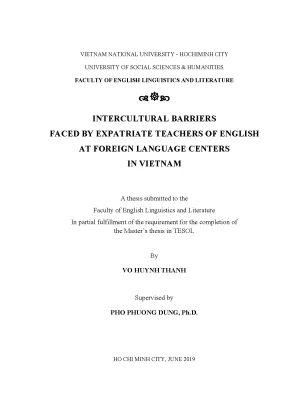Rào cản văn hóa mà giáo viên nước ngoài gặp phải tại các trung tâm ngoại ngữ ở Việt Nam
Trường đại học
Vietnam National University - Ho Chi Minh City University of Social Sciences & HumanitiesChuyên ngành
TESOLNgười đăng
Ẩn danhThể loại
Thesis2019
Phí lưu trữ
30.000 VNĐMục lục chi tiết

Bạn đang xem trước tài liệu:
Intercultural barriers faced by expatriate teachers of english at foreign language centers in vietnam m a
THÔNG TIN CHI TIẾT
Tác giả: Võ Huỳnh Thanh
Người hướng dẫn: Phó Phương Dung, Ph.
Trường học: Vietnam National University - Ho Chi Minh City University of Social Sciences & Humanities
Chuyên ngành: TESOL
Đề tài: Rào Cản Văn Hóa Đối Với Giáo Viên Nước Ngoài Tại Các Trung Tâm Ngoại Ngữ Ở Việt Nam
Loại tài liệu: Thesis
Năm xuất bản: 2019
Địa điểm: Ho Chi Minh City
Tài liệu "Rào cản văn hóa đối với giáo viên nước ngoài tại các trung tâm ngoại ngữ ở Việt Nam" khám phá những thách thức mà giáo viên nước ngoài phải đối mặt khi làm việc trong môi trường giáo dục tại Việt Nam. Bài viết nêu bật các yếu tố văn hóa có thể gây khó khăn cho việc giao tiếp và tương tác giữa giáo viên và học sinh, từ đó ảnh hưởng đến chất lượng giảng dạy. Độc giả sẽ nhận thấy rằng việc hiểu rõ những rào cản này không chỉ giúp cải thiện môi trường học tập mà còn tạo ra cơ hội cho sự phát triển bền vững trong giáo dục.
Để mở rộng kiến thức về giá trị văn hóa và sự phát triển bền vững, bạn có thể tham khảo tài liệu Luận văn phát huy giá trị văn hóa truyền thống trong phát triển bền vững tại tây nguyên giai đoạn hiện nay, nơi bàn về cách thức bảo tồn và phát huy giá trị văn hóa trong bối cảnh hiện đại. Ngoài ra, tài liệu Luận văn khảo cứu văn bản du hiên thi thảo của bùi văn dị cũng cung cấp cái nhìn sâu sắc về giá trị văn hóa và lịch sử, giúp bạn hiểu rõ hơn về bối cảnh văn hóa tại Việt Nam. Cuối cùng, tài liệu Luận văn khảo cứu văn bản dịch phu tùng thuyết sẽ giúp bạn khám phá thêm về các khía cạnh dịch thuật và văn hóa trong giáo dục. Những tài liệu này sẽ là nguồn tài nguyên quý giá cho những ai muốn tìm hiểu sâu hơn về mối liên hệ giữa văn hóa và giáo dục tại Việt Nam.